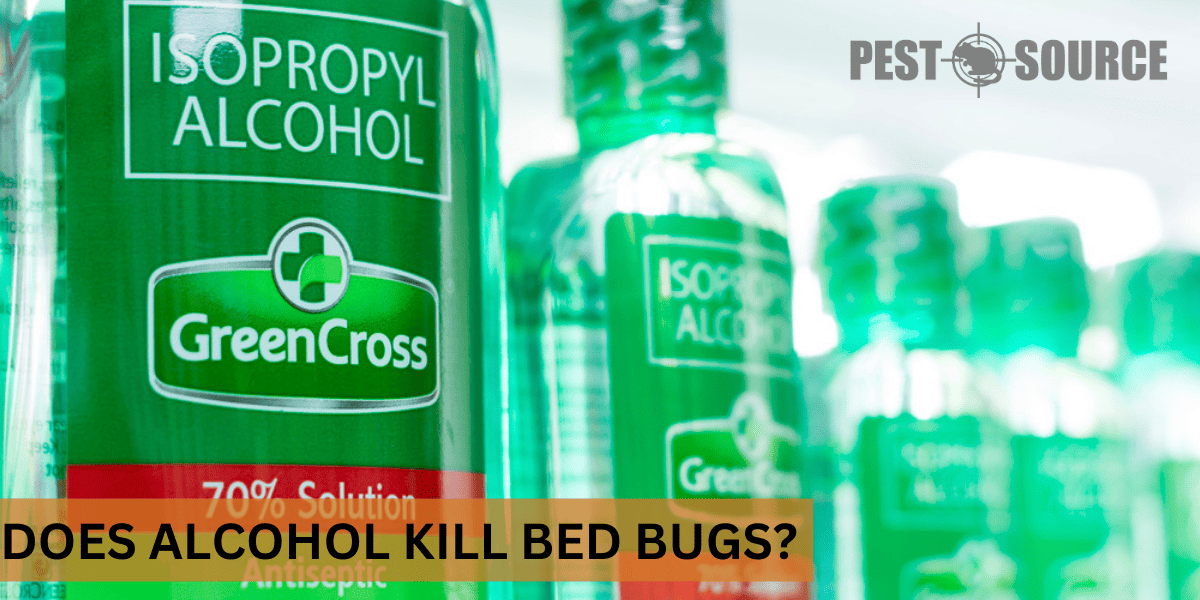Alcohol can kill bed bugs on contact by dissolving their outer cells, but it’s not a comprehensive solution. Its effectiveness is limited to direct application, meaning it won’t eliminate hidden bugs or eggs. This post will examine the use of alcohol as a bed bug treatment, discussing its pros and cons, and why professional pest control methods are often more effective.
POINTS
- Alcohol, including rubbing and isopropyl types, can kill bed bugs but only on direct contact. It penetrates the bug’s exoskeleton and dehydrates them to death. However, it is not effective against eggs.
- Despite its ability to kill bed bugs on direct contact, alcohol is not an effective solution for bed bug infestations. It’s unable to reach those bugs that hide successfully in various nooks and crannies, such as mattress seams and furniture cracks.
- Alcohol’s impact on bed bugs is immediate, but the effect does not last long due to quick evaporation. This property makes it an unreliable in providing long-term protection against these pests.
- Using alcohol as a method of bed bug control has significant safety risks due to its high flammability. Spraying it freely across your home can increase the chance of accidental fires.
- There are safer, more reliable alternatives to alcohol for bed bug control, such as an Integrated Pest Management (IPM) approach. This strategy can combine heat treatment, pest-specific pesticides, and professional pest control services for a more comprehensive solution to bed bug infestations.
Why is Alcohol Considered for Bed Bug Control?
Alcohol is considered for bed bug control primarily due to its accessibility and disinfecting properties.
What is alcohol?
Alcohol, specifically ethyl or isopropyl alcohol, is a colorless liquid that evaporates quickly. It is commonly utilized as a cleaning and disinfecting agent because it can break down proteins and lipids, which are essential components of many organisms, including bed bugs.
Why do people believe alcohol kills bed bugs?
People believe alcohol kills bed bugs because of its ability to dehydrate or dry out insects upon contact. The idea is that the alcohol penetrates the exoskeleton of the bed bugs and dries them out, resulting in their death.
What types of alcohol are often mentioned in relation to bed bug control?
Rubbing alcohol, green alcohol, and isopropyl alcohol are often mentioned in relation to bed bug control. Rubbing and isopropyl alcohols are widely available and relatively cheap, making them widely used household disinfectants. Green alcohol, on the other hand, is typically a plant-based alcohol like ethanol, which some believe is a safer or more natural option.
The Effectiveness of Alcohol Against Bed Bugs
Does alcohol kill bed bugs?
Yes, alcohol can technically kill bed bugs. However, it’s worth emphasizing that alcohol alone is not an effective solution for an infestation, as it does not kill eggs and needs to be applied directly to all bugs to be effective, which is impractical given their expert hiding abilities.
How does alcohol affect bed bugs?
Alcohol affects bed bugs by drying out their bodies, effectively dehydrating them to death. However, this requires a direct hit. If you miss even a tiny fraction of an infestation, those bugs can continue to multiply rapidly.
Can rubbing alcohol kill bed bugs?
Rubbing alcohol can kill bed bugs, but it should be clarified that it must be sprayed directly onto them.
Does isopropyl alcohol kill bed bugs?
Just like rubbing alcohol, isopropyl alcohol can kill bed bugs. But the survival of eggs and all the bugs you can’t find to spray will mean that your infestation continues.
What does alcohol do to bed bugs?
When sprayed directly onto bed bugs, alcohol can permeate their exoskeleton and cause them to dry out and die.
Can alcohol kill bed bugs eggs?
Unfortunately, alcohol does not effectively kill bed bug eggs. The eggs are coated in a protective layer that makes it difficult for substances like alcohol to penetrate. This means that even if you kill all the adult bugs, a new batch of pests can hatch and continue the infestation.
The Mechanism of Using Alcohol for Bed Bug Control
What happens if you spray alcohol directly on bed bugs?
When you spray alcohol directly on bed bugs, it can penetrate their protective exoskeleton and dehydrate them to the point of death. But remember, this technique is only effective if every single bug is sprayed directly.
What happens if I spray rubbing alcohol on my bed?
Spraying rubbing alcohol on your bed can kill any bed bugs that are present at the moment of spraying. However, bed bugs tend to hide in cracks and crevices when not in active feeding mode, meaning many will evade your efforts.
What happens if you spray alcohol on a mattress?
Spraying alcohol on a mattress will likely kill only part of the bed bug population. As alcohol dries quickly, it will not provide long-term protection. Bugs hiding, or those eggs that alcohol doesn’t kill will continue the cycle of infestation.
What does spraying alcohol on your bed do?
Spraying alcohol on your bed may kill bed bugs on contact, but it won’t provide a long-term solution because it does not affect those hiding or immature bugs and eggs.
Does rubbing alcohol kill bed bugs instantly?
If sprayed directly onto them, rubbing alcohol can kill bed bugs relatively quickly. Still, it doesn’t result in immediate death, and any bugs you miss can continue to reproduce.
How long does it take for rubbing alcohol to kill bed bugs?
It takes a few minutes for rubbing alcohol to kill bed bugs after direct application. However, it’s not a lasting solution since the alcohol dries very quickly and will not continue to kill bugs after it has evaporated.
The Drawbacks and Risks of Using Alcohol to Kill Bed Bugs
Why is alcohol not an effective treatment for a bed bug infestation?
Alcohol is not an effective treatment for bed bug infestations due to its inability to kill eggs or bugs that you don’t directly hit with the spray. Moreover, its effects don’t last long as it evaporates quickly.
Why is it not practical to use alcohol to kill all bed bugs in an infestation?
It’s not practical to use alcohol to kill bed bugs in an infestation because they are incredibly skilled at hiding. To effectively eliminate a bed bug infestation with alcohol, you would need to find and spray every single bug, a near-impossible task.
What are the safety concerns with using alcohol to kill bed bugs?
One major safety concern is that alcohol is a flammable substance. Accidental ignition could lead to house fires. Using it liberally around your house can pose a significant fire risk.
Why is alcohol considered dangerous when used for bed bug control?
Aside from the high risk of fire, alcohol vapors can be harmful if inhaled in large amounts. Also, alcohol can dry out and damage certain materials, such as wood or delicate fabrics.
Why is it risky to spray your bed with alcohol at night?
Spraying your bed with alcohol at night is risky because your sheets and pillows may become saturated with a highly flammable liquid. Any spark or source of heat could potentially ignite it.
Why does alcohol get rid of bed bugs only to a limited extent?
As mentioned, alcohol can only kill on direct contact, falling short against eggs and those bugs in hiding, which allows the infestation to rebound quickly. It’s simply a quick fix, not a long-term solution.
Practical Usage of Alcohol in Bed Bug Control
What are the precautions when using alcohol to kill bed bugs?
Firstly, remember that alcohol is flammable, so avoid using it near open flames or potential sources of ignition. Always use it in a well-ventilated area to avoid inhaling fumes. Lastly, it’s crucial to note that alcohol should only be seen as a quick fix and not a long-term strategy for bed bug control.
How to spray your bed with alcohol at night?
If you plan to spray your bed with alcohol at night, use a spray bottle and clean gloves for your safety. Lightly mist the mattress and sheets with the alcohol, being careful not to oversaturate the materials as this presents a fire risk.
Why spray your bed with alcohol at night?
It might seem useful to spray your bed with alcohol at night as bed bugs are nocturnal by nature and this is when they are likely to venture out for a meal. However, as already stated, realize that while this method may kill some bugs, it’s not an effective solution for an infestation.
Does spraying alcohol kill bed bugs?
Yes, spraying alcohol directly onto bed bugs can kill them. However, its application must be direct, and it has no effect on eggs, rendering it ineffective against a full-blown infestation.
Does rubbing alcohol kill bed bugs instantly?
Rubbing alcohol can kill bed bugs fairly rapidly after direct contact. However, it does not lead to immediate death and is ineffective against eggs and bugs not directly sprayed.
Alternatives to Alcohol for Bed Bug Control
Does green alcohol kill bed bugs?
Like other types of alcohol, green alcohol can kill bed bugs but only on direct contact. It’s also ineffective against bed bug eggs.
Does alcohol get rid of bed bugs or just kill them?
Alcohol can just kill bed bugs on direct contact but doesn’t get rid of the entire infestation, especially the eggs.
Are there better ways than alcohol to kill bed bugs and their eggs?
Yes, there are more effective ways to eliminate bed bugs and their eggs. Integrated Pest Management (IPM) approaches including a combination of heat treatment, pesticides specifically designed for bed bugs, and professional pest control services are all more reliable and complete strategies to handle an infestation.
Does Bleach Kill Bed Bugs?
Yes, bleach can kill bed bugs upon direct contact due to its strong chemical properties which are lethal to these insects. Bleach contains sodium hypochlorite, which can destroy bed bugs by disrupting their nervous system and causing their bodily functions to fail. However, using bleach as a bed bug treatment is not recommended due to its corrosive nature and potential to damage fabrics, surfaces, and pose risks to human health if not used with proper precautions.



